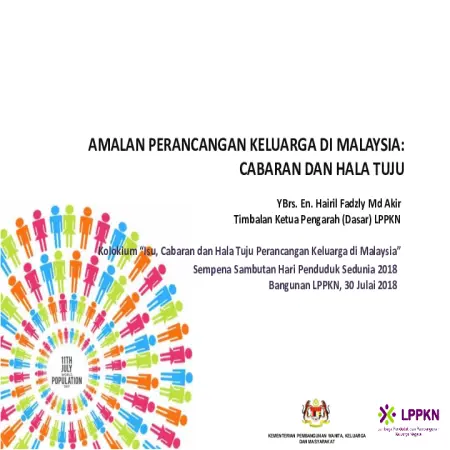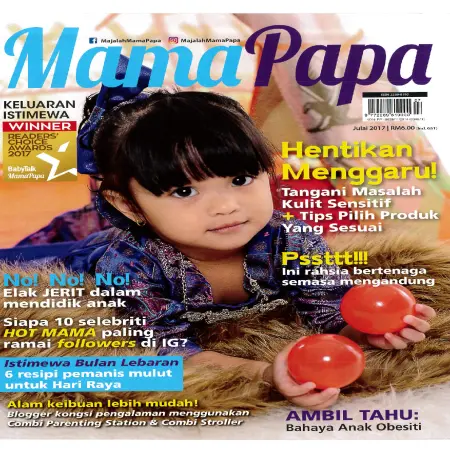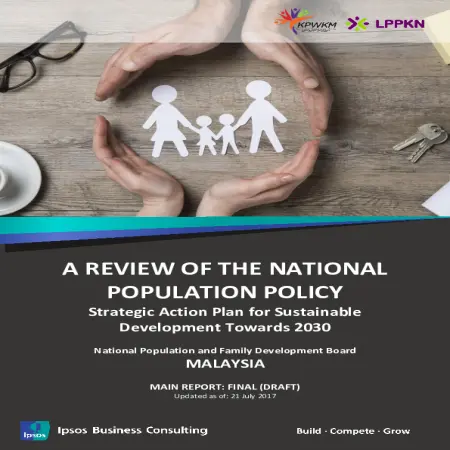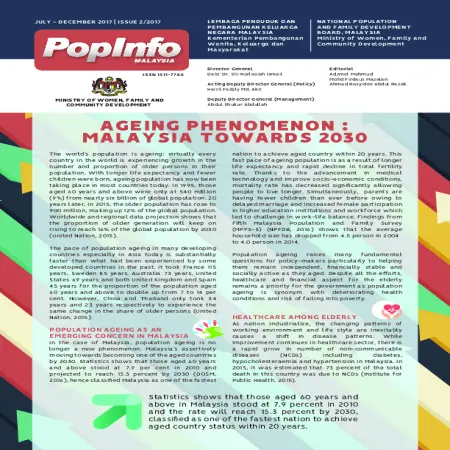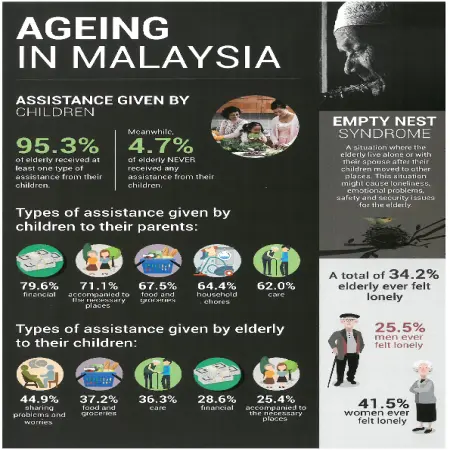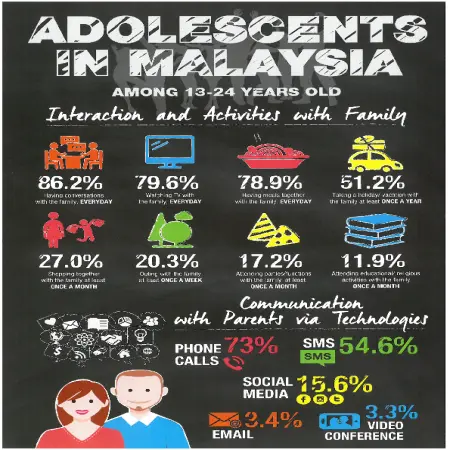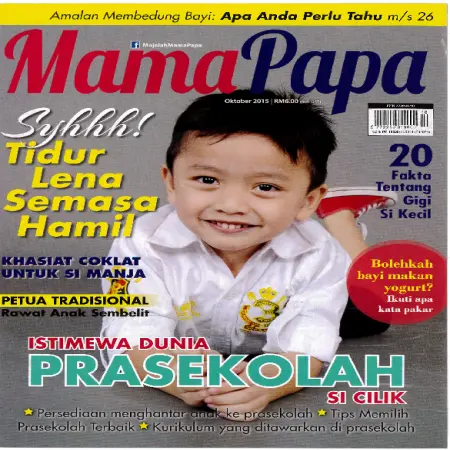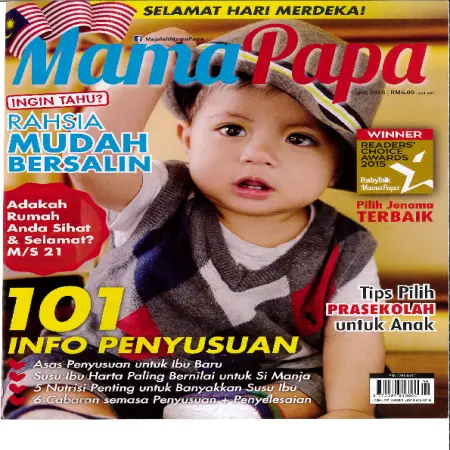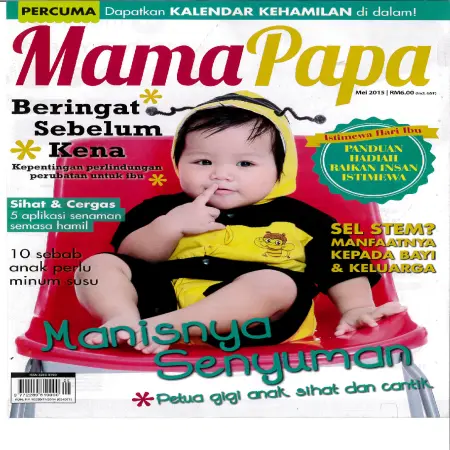Browse by Year
|
|
Amalan perancangan keluarga di Malaysia: cabaran dan hala tuju
Item Type: Conference or Workshop Item
Editor:
Year: 00/00/2018
Abstract: Family planning allows people to attain their desired number of children and determine the spacing of pregnancies. It is achived through use of contraceptive method and the treatment of infertility. Proportion of women of reproductive aged 15-49 years who have their need for family planning satisfied with modern methods.
|
|
|
|
|
|
Ajar anak hargai ibu bapa
Item Type: Article
Editor:
Year: 00/07/2017
Abstract: Parents are the most important people in everyone's life. Their service to us is priceless. Ever since we were in the womb, the mother has carried us in her womb for 9 months and 10 days and it is the mother who gave birth to us. Not to be forgotten is also the role of the father who is the leader and takes care of us to the best of our ability. We can show love to our parents by respecting and obeying them. Our parents have instilled pure values in us and educated us since childhood to the best of our ability.
|
|
|
|
|
|
A Review of The National Population Policy : Strategic Action Plan for Sustainable Development Towards 2030.
Item Type: Report
Editor:
Year: 00/07/2017
Abstract: Globalization, technology, and the continuous strive for progress has changed the way people work, live, and build relationships with each other. Across the world, more people are traveling across borders for work, as the world becomes smaller and open markets continue to emerge; people are flocking to the largest cities, creating more pressure on infrastructure, housing and jobs, while also representing social challenges; the rise of the ‘me-culture’ versus the concern and responsibility for the collective ‘family’ is set to continue, while family formation is occurring later and trending towards small-sized norms. Technology, while it has made us all more connected, has made us lonelier as well.
Malaysia is not immune to these global trends. The world is evolving rapidly: new jobs that did not exist before are being created every day, giving rise to an unpredictable future. In order to prepare Malaysians to excel in such an unpredictable future, an effective population policy, updated to best meet the nation’s on-going and future population challenges, needs to be in place.
|
|
|
|
|
|
Ageing phenomenon: Malaysia towards 2030
Item Type: Newsletter
Editor:
Year: 00/00/2017
Abstract: Statistics shows that those aged 60 years and above in Malaysia stood at 7.9 % in 2010 and the rate will reach 15.3 % by 2030, classified as one of the fastest nation to achieve aged country status within 20 years. This fast pace of ageing population is as a result of longer life expectancy and rapid decline in total fertility rate.
|
|
|
|
|
|
Analisis strategi kelangsungan hidup migran pekerja Bugis Indonesia ke Sabah
Item Type: Conference or Workshop Item
Editor:
Year: 00/00/2016
Abstract: Bugis migration to Sabah especially the Tawau Division in the 19th Century not only had provided the workforce but also created the early Bugis community in Sabah. They had assimilated with local people and become Malaysian citizens after the formation of Malaysia in 1963. Bugis migration flow to Sabah still continues to date and it is difficult to control. This paper studies migration of Indonesian workers phenomenon, especially the Bugis who dominate a few districts in Tawau and Sandakan Divisions. In collaboration with the LPPKN, a study involving 896 Indonesian workers who responded to a survey was conducted using face-to-face interview, while 20 legal and illegal workers, respectively participated in the in-depth interview. This study focuses on survival strategies using the role of social network in assisting migration process in three phases namely pre, while and post migration. This study found that new migrants were assisted by social network to reduce migration cost to achieve successful migration. Based on the Push and Pull theory, the decision to migrate and the selection of migration destination was influenced by economic factors such as job opportunity and wages in the origin and destination which could be explained by Neo Classical Economy theory. What is more important was, this study found that, non-economic pull factors such as social network, historical links and geographical proximity; as well as culture, ethnicity, religion and language similarity strongly influenced new migrants in making the decision to migrate. In conclusion, survival strategies using trusted social network crosses political boundary has continued to assist flow of information and resources, and reduced the risk of unsuccessful migration. Ethnicity-based recruitment strategy assisted by Mandur was found to be beneficial and thus, maintaining the migration flow of Bugis to Sabah until today.
|
|
|
|
|
|
Antara hak dan tanggungjawab membimbing anak bertanggungjawab
Item Type: Article
Editor:
Year: 00/10/2015
Abstract: Rights can be defined as belonging to each individual while responsibilities are something that must be exercised. Kids who like to take people’s stuff have impulsive traits. Impulsive means someone who has a strong urge to have something. When the desire peaked, he had to get it right away. Some tips are shared to parents when faced with this situation such as encouraging children to ask permission every time they want to borrow items that do not belong to them, explaining to children about the difference between borrowing and taking other people's items without permission and consistent and firm in correcting actions. misconduct of children.
|
|
|
|
|
|
Aduh! Sakit kepalaku: membimbing anak bertanggungjawab
Item Type: Article
Editor:
Year: 00/08/2015
Abstract: Every child born into this world is a perfect and holy gift of God. Children are like white cloth and it is the parents who are responsible for shaping the life of their children. Every child born is in perfect condition and has great potential to be an excellent human being. Fatherhood and Motherhood The LPPKN Family@Work Module provides guidance to participants on the style of fatherhood, namely Authoritarian, Permissive, Neglect and Authoritative. The fact is, as a parent the goal is to raise children to be happy, healthy and successful.
|
|
|
|
|
|
Apa wanita perlu tahu: subur@tidak subur?
Item Type: Article
Editor:
Year: 00/05/2015
Abstract: Fertility is the ability to conceive naturally. As a measure, fertility rate is the number of children born per individual, household or population. Fertility varies according to fertility, i.e. the potential to reproduce (which is influenced by gamete production, fertilization and the ability to conceive long enough). There are several types of ovulation disorders that are 35% of the cause of infertility in women, namely anovulation. Anovulation is a condition where no ovulation process occurs or the egg process is released from the ovaries, oligovulation is an irregular ovulation process that sometimes occurs, sometimes not and the anovulation cycle is a menstrual cycle in which no ovulation process occurs at the cycle.
|
|
|
|





